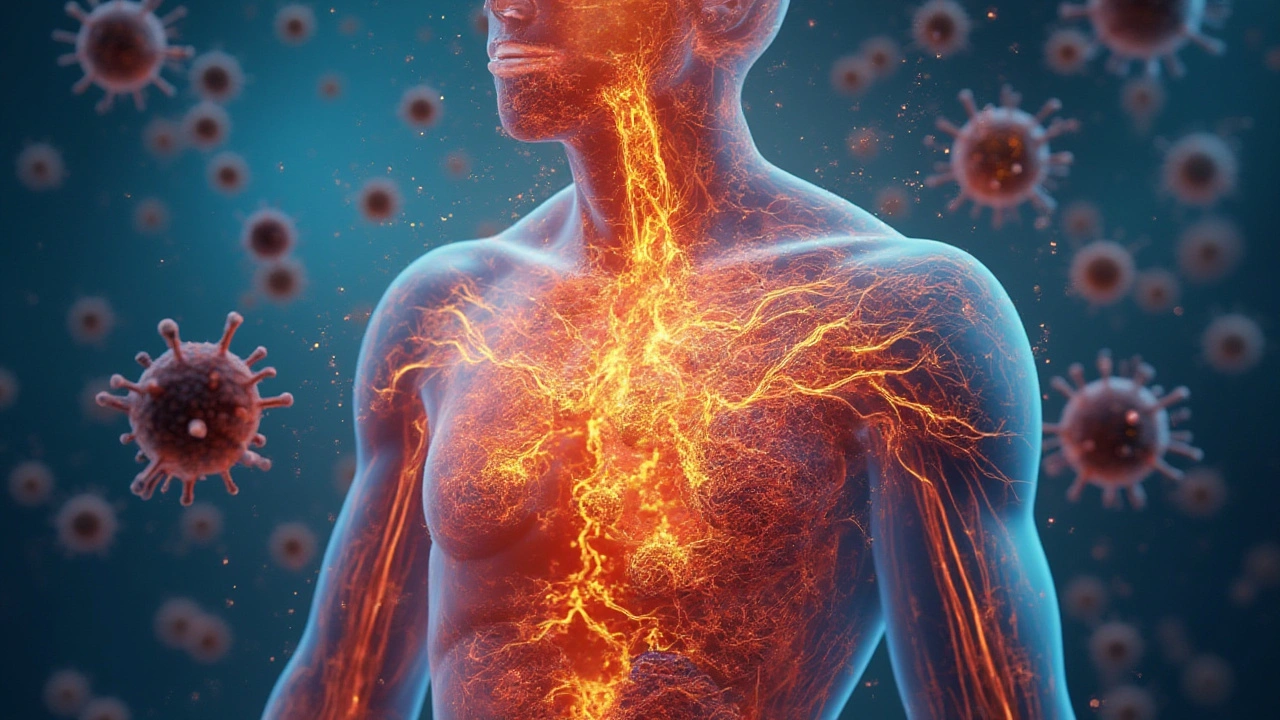Ever wondered why some people eat a mountain of pasta and feel just fine, while others end up stuck on the couch, cramping or worse? Or how your body knows to heal a paper cut, manage sugar from breakfast, or convert a late-night snack into energy for that early gym session? There’s a hidden world inside us—the world of enzymes—doing all the hard work. Without them, few things in your body would happen fast enough to keep you alive.
How Enzymes Work: The Tiny Machines Inside Us
Enzymes aren’t just a science class buzzword; they’re more like tiny robots, each built to do a very specific job inside your body. Nearly every chemical reaction in your system—from digesting lunch to repairing DNA—depends on enzymes. These proteins latch onto molecules, speed up chemical changes, and let things run smoothly. Imagine your body without them: it’d be like waiting years for toast to brown or water to freeze in the sun. Nobody’s got time for that.
Here’s how they get the job done: enzymes have special shapes with grooves (scientists call this the 'active site'), which fit exactly with certain molecules, sort of like a lock and key. When the right key fits, the enzyme puts it to work—splitting, joining, or changing it in just the right way. Your saliva alone has the enzyme amylase, which starts breaking down bread into sugars before you even swallow.
Most enzymes are picky. Lactase, for example, only breaks down lactose (the sugar in milk). DNA polymerase helps your cells copy DNA, but it won’t touch a burger. This specificity is why one missing enzyme can cause big problems. When things go wrong here, you’re not just “a little slow”—sometimes your body can’t get energy, can’t build tissue, or starts building up poisons that make you sick.
Lately, researchers have been able to see these reactions happen, frame by frame, in the lab. They’ve measured enzymes speeding up reactions by factors of a billion or more. Want to see the difference? Take carbonic anhydrase—a single enzyme can join water and carbon dioxide in your blood 36 million times faster than the reaction would go without it. Forget waiting for the fizz to build up; you'd be done for before your soda lost its bubbles.
Here’s something wild: your body can make over 75,000 different enzymes. Each one has a particular job, and the system is constantly balancing them out—making sure you’ve got enough around when you need them, breaking them down when they’re old, and swapping in new models when necessary.
What Happens When Enzymes Go Missing?
It’s not a mystery what happens when these tiny workers call in sick. Imagine a factory where half the workers don’t show up: nothing gets built, things pile up, and sooner or later, stuff goes bad. When you’re missing even one critical enzyme, life gets complicated. Here’s a taste of what can go wrong:
- Lactose Intolerance: Without lactase, instead of digesting milk smoothly, you’re left with cramps, gas, and a good reason to avoid ice cream socials. It’s one of the most common enzyme issues and affects nearly 65% of the global population.
- Phenylketonuria (PKU): Missing the enzyme phenylalanine hydroxylase leads to a buildup of phenylalanine, which, if untreated, can cause serious brain damage in babies. This is why newborns in the U.S. get a heel prick test to catch PKU right away.
- Tay-Sachs Disease: Missing the enzyme hexosaminidase A allows fatty substances to build up in the brain, leading to devastating neurological damage. Sadly, it’s a prime example of how missing a single enzyme can have tragic consequences.
- Gout: Without enough uricase, uric acid builds up, forming painful crystals in your joints. It’s not just old-fashioned—now, high-protein diets and craft beer can make it more common.
Some enzyme shortages aren’t genetic; they’re triggered by disease, medications, or even aging. Take pancreatic enzyme deficiency: it can be caused by cystic fibrosis, pancreatitis, or just getting older. Without these enzymes, it’s hard to break down fats and proteins, leaving you running to the bathroom or dropping weight for no apparent reason.
The catch? You often don’t miss enzymes until problems snowball—a fact that makes diagnosis tricky. Sometimes, noticing unexpected issues (like weird rashes, muscle weakness, or extreme fatigue) is the only thing that gets people tested.
If you want a snapshot, check out this table with common enzyme deficiencies and what they do:
| Enzyme | Deficiency Effect | Typical Symptoms |
|---|---|---|
| Lactase | Lactose Intolerance | Cramps, diarrhea, bloating |
| Hexosaminidase A | Tay-Sachs Disease | Loss of motor skills, blindness, death |
| Phenylalanine hydroxylase | PKU (Phenylketonuria) | Mental disability, seizures |
| Glucose-6-phosphate dehydrogenase | G6PD Deficiency | Anemia, jaundice |
| Pancreatic enzymes | Pancreatic insufficiency | Weight loss, fatty stool, malnutrition |
Falling short on enzymes doesn’t just mess up one system. It’s a domino effect: undigested food leads to inflammation, irritation, allergies, and sometimes chronic fatigue. When toxins pile up, organs like your liver and kidneys work overtime and can fail. If your kids ever ask, “Why do I have to drink this gross medicine?” after being diagnosed, you can tell them their body is missing one of these key molecules.

Everyday Enzyme Helpers: Can You Fix a Deficiency?
Can you eat your way to better enzyme health? Not exactly, but food and lifestyle play a bigger role than you might think. Fermented foods—think kimchi, sauerkraut, miso—aren’t just trendy; they’re sometimes bursting with natural enzymes that help your body break down what you eat. That’s part of why you’ll see digestive enzyme supplements flying off health food shelves.
Here’s the thing with enzyme pills: they’re not magic, but they can help if you’ve got a real deficiency. People with lactose intolerance double down on lactase pills before cheese platters. Folks with chronic pancreatitis or cystic fibrosis might get prescription-strength enzymes. Still, if you’re healthy, popping enzymes won’t turn you into a superhuman or let you eat ten plates of ribs without consequences.
Your body has a clever failsafe: it tends to slow down on making enzymes with age, but eating a variety of foods and staying active gives your system the best shot at running smoothly. There isn’t a food that “replaces” missing enzymes for issues like PKU or Tay-Sachs—those require medical intervention, usually strict diets, and plenty of checkups.
Don’t forget about hydration. Enzymes work best in watery places—your mouth, stomach, intestines. Dehydration means a sluggish system, so sometimes, sipping more water can actually help every reaction tick along a little faster. People who crash on extreme “detox” diets often lose out on enzyme function because they’re missing nutrients or getting too little fat to keep their body building those key proteins.
- If you suspect something’s off, see a medical provider—a blood or urine test can pinpoint many enzyme issues.
- For rare genetic enzyme problems, early diagnosis means a world of difference; some can be treated before symptoms even show up.
- Avoid “miracle” supplements that claim to boost every enzyme in your body. Stick to what your doctor suggests.
- If you’re caring for someone with enzyme disease, tiny changes—like prepping softer foods or logging reactions to new foods—can make a huge difference.
Vivian, my partner, has tried every lactose-free product on the market. Some help, some are just clever marketing. If you’re in her camp, don’t be ashamed to ask what works—sometimes only a bit of planning turns a miserable day into an easy one.
The Big Picture: Enzymes in Modern Medicine and Research
Enzymes don’t just handle breakfast inside your body; they’re at the front line in science labs and hospitals, tackling everything from cancer to COVID-19. Pharmaceutical companies now design enzyme-based drugs that target only the broken parts—meaning less collateral damage compared to older meds. A new enzyme therapy for Fabry disease just passed the FDA’s latest review, giving hope to families who had zero options a decade ago.
Researchers are also engineering enzymes for better diagnostics. The COVID-19 rapid tests used enzymes to quickly multiply virus genes so labs could find infection fast—this saved lives and sped up the whole response.
There’s fascinating research on using “designer enzymes” to break down plastics or tackle pollution. In medicine, doctors use enzyme replacement therapy (ERT) to give patients missing molecules, and success stories keep popping up for rare diseases. Some hospitals now use CRISPR, an enzyme-based tool, as genetic scissors to edit out broken genes and possibly cure hereditary enzyme shortages.
On the flip side, enzyme inhibitors—substances that stop certain enzymes—are vital for treating cancer, heart disease, and even depression. Common drugs like statins work by blocking enzymes that produce cholesterol. The future isn’t just about adding or fixing enzymes but knowing when to slow them down, speed them up, or switch them off altogether.
Here’s a fun fact to take away: your tears, saliva, even sweat, all have enzymes in them. The next time your eyes well up during a movie or you sweat it out at the gym, remember—your body’s running millions of enzyme-driven chemical reactions at once, turning ordinary food and simple molecules into everything you are. Ignore these microscopic powerhouses, and things fall apart fast. Pay attention, and you just might outsmart your body’s messier moments, one enzyme at a time.


Comments (8)
Richard Elias July 24 2025
bro i ate a whole wheel of brie last night and thought i was gonna die. turns out i'm lactose intolerant and i didn't even know it. this post is 100% spot on. enzymes are the real MVPs and nobody talks about them. i'm getting those lactase pills now. 🤯Scott McKenzie July 24 2025
Really appreciate this breakdown. 🙌 I work in nutrition and see people struggle with 'mysterious' digestive issues all the time. Enzyme deficiencies are way more common than people think. Fermented foods help, but if you've got a genetic issue like G6PD or PKU, supplements won't cut it. Always get tested. Your gut will thank you.Jeremy Mattocks July 25 2025
I used to think enzymes were just some fancy bio term until my kid got diagnosed with PKU. Now I'm the guy reading ingredient labels like they're ancient scrolls. It's insane how one missing protein can flip your whole life upside down. But here's the thing - early detection saved us. Newborn screening isn't just bureaucracy, it's a lifeline. And yeah, the diet's brutal - no nuts, no soy, no processed anything - but we're alive and thriving. If you're reading this and your kid has unexplained developmental delays, don't wait. Get the test. It's not scary if you catch it early. It's terrifying if you don't.Paul Baker July 26 2025
so like enzymes are basically the body's little workers right like they do all the stuff we dont think about like breaking down that pizza you ate at 2am and if you dont have enough you just like boom bellyache and cant function lol and also i heard some people take enzyme pills and think its magic but nope its not a cheat code you still gotta eat good food and drink water and stop eating chips all day 🤷♂️Zack Harmon July 26 2025
THIS IS A CRY FOR HELP. MY BODY IS A BROKEN FACTORY. I’M MISSING ENZYMES LIKE A PHONE WITH NO BATTERY. I ATE A BURGER AND FELT LIKE I WAS BEING STABBED FROM INSIDE. I WASN’T EVEN DRINKING ALCOHOL. I THOUGHT I WAS JUST ‘SLOW’ OR ‘UNFIT.’ NOW I KNOW. I’M A HUMAN GLITCH. SOMEONE PLEASE INVENT AN ENZYME UPGRADE. I’M SENDING MY LAST EMAIL BEFORE I CRY IN THE BATHROOM AGAIN.Jeremy S. July 28 2025
This is actually really useful. I had no idea enzyme issues could cause fatigue or rashes. I thought it was just stress or bad sleep. Maybe I should get tested.Jill Ann Hays July 28 2025
The biochemical precision of enzymatic catalysis represents an extraordinary evolutionary adaptation wherein molecular specificity ensures metabolic fidelity. Absence of requisite enzymes precipitates substrate accumulation with downstream pathophysiological consequences. One must therefore recognize that dietary supplementation cannot rectify congenital enzymopathies without medical oversight. The conflation of functional digestive aids with therapeutic interventions is a pervasive public misconception.Mike Rothschild July 28 2025
I’ve been a nurse for 20 years and I’ve seen people suffer for years because they didn’t connect their symptoms to enzymes. Fatigue, bloating, weight loss - all dismissed as ‘stress.’ If you’re feeling off and nothing seems to fix it, ask your doctor about enzyme panels. It’s not a wild guess. It’s a simple blood test. You don’t need a miracle. You just need to know what’s broken. And you’re not alone.